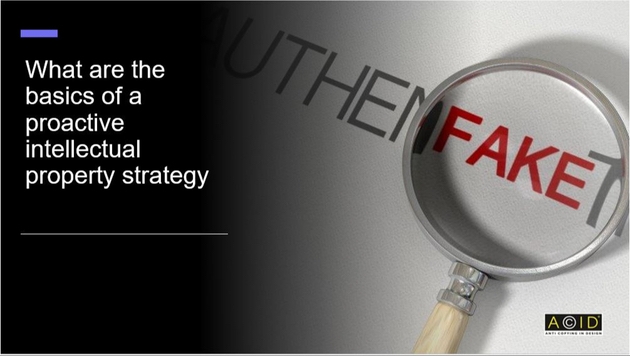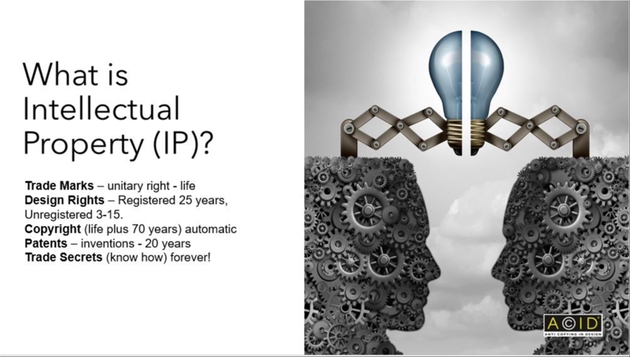
With a seismic shift towards online trading, it is now more important than ever to create a simple, proactive approach to the intellectual property you are creating to ensure that your designs are safe, from idea to marketplace. The UK is still one of the most innovative and creative countries in the world and as we are living within one of the most challenging times, innovation is needed now more than ever. Being a designer takes a lot of skill and creativity and it is important you protect your work. It's a competitive world out there and it's the creative talent, skills, and training that you have which distinguishes you from other designers and their designs and creations.
Hopefully as we learn to manage this terrible crisis and, in the fullness of time as we emerge, it is important to think about design protection, what to do if things go wrong and seeing IP as a positive force for growth.Intellectual property is a property right – so in the same way as you may own, lease, sell, sub-let, rent, or share your home - you don't want squatting. IP is about ownership and permission to use your property i.e., your IP rights.

1. IP rights are split into two main categories – those you must register and those that arise automatically.
2. Copyright in the UK arises automatically and in the UK is non registrable – you don't have to do anything to own a copyright work as long as it fits the criteria which is laid down in legislation. Is it original, for example? Copyright covers a whole range of day to day business tools. Not only does it cover works of art and images, but it covers text that you create. It is not just text in books but on your website and in the information that you give out to the public, internal communications, letters, emails. It also covers photographs, software, and contracts. Copyright happens as soon as the work in question is put in to a permanent form and that includes where it is stored on a computer. Whilst copyright works cannot be registered, they can be lodged on the ACID IP Databank, giving third party evidence of their existence on the date they are received, valuable in creating an audit trail behind your work.
3. Trade marks are badges of origin and their role is to differentiate you from other people in the market space; your brand. Trade marks can be names, logos and in certain circumstances they can even be colours, smells, and sounds. If you are trading under your own name you can use the TM symbol which means you are relying on an unregistered trade mark. Registration comes with several benefits over unregistered rights. A registered trade mark gives you the right to that name and in respect of that area of business that you have it registered for across the whole of the territory, in this case the UK.
4. Design rights essentially cover the shape of an article. In the UK, unregistered rights only last for approximately 10 years and the equivalent EU right lasts for only three years. Another drawback of unregistered design rights is that they in the last 5 years that the right exists, if somebody wishes to use your design and they are prepared to pay for it, you have to allow that person or business to take what is called a Licence of Right. The benefit of a registered design is that you do not have to allow your competitors to use your rights and they last for a significantly longer period of time, 25 years.
5. Patents cover inventions where you solve a problem. They cover a concept and last for 20 years. Patents must be registered and are often expensive and time consuming. If you disclose or publish your work before it is registered it becomes invalid.
6. Trade Secrets; are one of the most important IP rights and are the crown jewels of most businesses. Why? Because it's about how you do business, who your contacts are, who your suppliers are, how you make things etc. We have all heard about the Coca Cola recipe and how it has been a secret for over a hundred years, but the issue with confidential information or trade secrets is that you must, must keep the information a secret. Ensure that you only share trade secrets carefully and, if necessary, include them in confidentiality agreements with those with whom you share them.
7. Agreements – from IP clauses in your Terms of Business, to ensuring that if you are using third party freelancers who are not your own employees, that you have contracts in place so that the work or the rights in the work are owned by you. Important if, for example, you are having photographs taken for marketing or a website. ACID has a menu of standard template agreements which can easily, and cost effectively be tailored to meet your needs. So, when you're talking to other people about your products, get them to sign confidentiality agreements. This will protect your knowhow so that if you give them confidential information about your business, it will remain confidential. It will also create a paper trail if they decide that they don't want to use you but want to copy you instead. It removes the question of whether or not they knew about you and copied you. Pay attention to the small print, you never know when you will need to rely on it!
8. IP Statement – If you don't want to be copied, say so! Permeating through all your marketing material and communications should be a strong message, that you have Intellectual Property rights and that you don't want to be copied.
9. Audit Trail – keep records of key stages in the creating of your work, signed, and dated or photographed and send them to the ACID IP Databank. Don't forget if you are relying on unregistered rights such as copyright or unregistered design rights, it is up to you to prove that you own your rights.
10. What to do if copied – Don't panic! Seek specialist IP and, preferably sector savvy advice, gather your evidence and remember, often, a carefully worded letter before action can get a result. Going all the way to a final and expensive Court hearing is a rare occurrence.
On 10th November at 11 am, ACID together with Niall Head-Rapson, Director of ACID legal affiliate McDaniel & Co, who helpfully contributed to the above ACID basics about IP rights, will be holding another in its series of webinars – Get IP savvy! Register here https://us02web.zoom.us/webinar/register/WN_SXsU_VahSZWIUoYl6VmnjA or look on our website for further details.